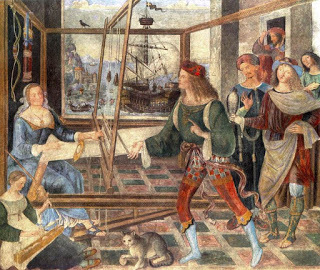MaryAnn Bernal's Blog, page 106
April 18, 2016
Archaeologists Discover a Resting Place for an Ancient Egyptian Sacred Boat
Ancient Origins
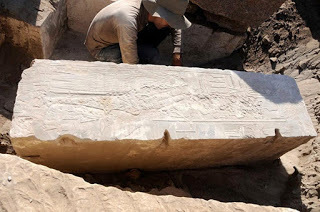 In ancient Egypt, sacred boats called barques were believed to ferry the dead to the afterlife, the sun god Ra across the sky, and various other gods and royalty up and down the Nile River.
In ancient Egypt, sacred boats called barques were believed to ferry the dead to the afterlife, the sun god Ra across the sky, and various other gods and royalty up and down the Nile River.
 [image error] Now a barque resting place made of stone blocks from the time of Queen Hatshepsut has been discovered on Elephantine Island and will give scholars some insight on the religion of her time, the Ministry of Antiquities announced on its Facebook page.
[image error] Now a barque resting place made of stone blocks from the time of Queen Hatshepsut has been discovered on Elephantine Island and will give scholars some insight on the religion of her time, the Ministry of Antiquities announced on its Facebook page.
The ancient Egyptian barque resting station that was part of a sacred building dating back to the time of Hatshepsut has been discovered on the island in the Nile River at Aswan.
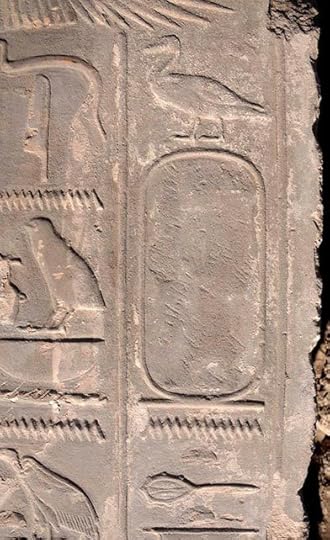 Erased name of queen Hatshepsut. (
German Archaeological Institute
)The German Archaeological Institute has found a number of blocks upon which the sacred boat would have rested when it was not being used in a procession, said Mahmoud Afify of the ministry.
Erased name of queen Hatshepsut. (
German Archaeological Institute
)The German Archaeological Institute has found a number of blocks upon which the sacred boat would have rested when it was not being used in a procession, said Mahmoud Afify of the ministry.
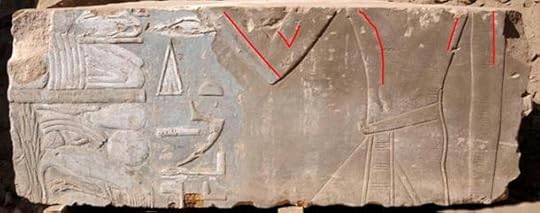 Female representation of Hatshepsut (highlighted by red lines) that was later replaced by the image of a male king. (
German Archaeological Institute
)Experts believe they can reconstruct the building’s appearance based on the blocks found so far. The building would probably have had a chamber lined on all four sides by pillars in which rested the god Khnum’s barque. The pillars bear representations of Khnum and other gods, including Imi-peref, which means “He who is in his house”; and Nebet-menit or “Lady of the mooring post”; and Min-Amun of Nubia.
Female representation of Hatshepsut (highlighted by red lines) that was later replaced by the image of a male king. (
German Archaeological Institute
)Experts believe they can reconstruct the building’s appearance based on the blocks found so far. The building would probably have had a chamber lined on all four sides by pillars in which rested the god Khnum’s barque. The pillars bear representations of Khnum and other gods, including Imi-peref, which means “He who is in his house”; and Nebet-menit or “Lady of the mooring post”; and Min-Amun of Nubia.
So, the discoveries add not just to the knowledge of Queen Hatshepsut but also help Egyptologists understand the religious milieu and beliefs on Elephantine Island during Hatshepsut’s reign, the press release states.
The barque station was probably watched over and guarded by priests when the boat was not in procession, says Heritage Daily in an article about the discoveries.
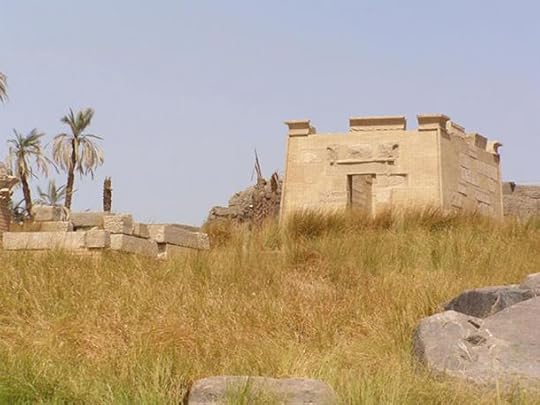 Ruins of the temple of Khnum, southern point of the island of Elephantine. (
CC BY SA 4.0
)Barques were used from the beginning of recorded history in Egypt. There are many depictions of them in reliefs and paintings. Ancient Egyptians believed barques were used to transport people to the afterlife, and images of the boats are depicted in many temples and tombs.
Ruins of the temple of Khnum, southern point of the island of Elephantine. (
CC BY SA 4.0
)Barques were used from the beginning of recorded history in Egypt. There are many depictions of them in reliefs and paintings. Ancient Egyptians believed barques were used to transport people to the afterlife, and images of the boats are depicted in many temples and tombs.
Unique Discovery Made in Egyptian Necropolis: Archaeologists Uncover a 4,500-Year-Old Funerary Boat Alongside Tomb of Unknown Elite, Who Was Not part of the Royal FamilyAncient temple dating back 3,500 years found near Aswan in EgyptAlso, the Egyptian god Ra was believed to have traveled in a barque. The Egypt Art Site states:
One legend states that each day, Ra was born and began a journey across the sky. Ra was believed to travel in the Manjet-boat. or the 'Barque of Millions of Years'. He was joined on this daily journey by a crew of many gods. The Manjet-boat would sail through the twelve provinces, representing the twelve hours of daylight. At the end of each day Ra was thought to die and embarked on his night voyage. For this journey he was called Auf, which means 'corpse.' Ra sailed in a boat called the Mesektet-boat or night-barque on his journey through the twelve hours of darkness. A solar barge on an Ancient Egyptian painted wooden stele of the 26th dynasty of Egypt. (
CC BY SA 2.5
)The page Reshafim.org has an article titled “Solar Ships and Funerary Boats” that says “Some of the divine vessels belonged wholly in the realm of mythology like the sun barks (msw-nb, skt.t); the bark of the other world qAytt; or the bark of the gods, the smj.w or smA.”
A solar barge on an Ancient Egyptian painted wooden stele of the 26th dynasty of Egypt. (
CC BY SA 2.5
)The page Reshafim.org has an article titled “Solar Ships and Funerary Boats” that says “Some of the divine vessels belonged wholly in the realm of mythology like the sun barks (msw-nb, skt.t); the bark of the other world qAytt; or the bark of the gods, the smj.w or smA.”
Featured Image: Pillar from the way station erected by Queen Hatshepsut for the god Khnum. Source: German Archaeological Institute
By Mark Miller
 In ancient Egypt, sacred boats called barques were believed to ferry the dead to the afterlife, the sun god Ra across the sky, and various other gods and royalty up and down the Nile River.
In ancient Egypt, sacred boats called barques were believed to ferry the dead to the afterlife, the sun god Ra across the sky, and various other gods and royalty up and down the Nile River. [image error] Now a barque resting place made of stone blocks from the time of Queen Hatshepsut has been discovered on Elephantine Island and will give scholars some insight on the religion of her time, the Ministry of Antiquities announced on its Facebook page.
[image error] Now a barque resting place made of stone blocks from the time of Queen Hatshepsut has been discovered on Elephantine Island and will give scholars some insight on the religion of her time, the Ministry of Antiquities announced on its Facebook page.The ancient Egyptian barque resting station that was part of a sacred building dating back to the time of Hatshepsut has been discovered on the island in the Nile River at Aswan.
 Erased name of queen Hatshepsut. (
German Archaeological Institute
)The German Archaeological Institute has found a number of blocks upon which the sacred boat would have rested when it was not being used in a procession, said Mahmoud Afify of the ministry.
Erased name of queen Hatshepsut. (
German Archaeological Institute
)The German Archaeological Institute has found a number of blocks upon which the sacred boat would have rested when it was not being used in a procession, said Mahmoud Afify of the ministry.“According to Dr. Felix Arnold, the field director of the mission, the building served as a way station for the festival barque of the god Khnum,” the ministry’s press release states. “The building was later dismantled and about 30 of its blocks have now been found in the foundations of the Khnum temple of Nectanebo II. Some of the blocks were discovered in previous excavation seasons by members of the Swiss Institute, but the meaning of the blocks has only now become clear.”Four New Kingdom rock-hewn tombs discovered in EgyptThe Abydos Boats: Transporting the Pharaohs Through the AfterlifeQueen Hatshepsut is represented as a woman on some of the blocks, so they must have been carved during the early years of her reign because in later years she was represented as a king, the ministry wrote in the press release. This is one of very few buildings from the early period of her reign to have been discovered so far. The only other buildings dating to the early period of Hatshepsut’s rule were discovered at Karnak. Hatshepsut was in power from 1508 to 1458 BC.
“The newly discovered building thus adds to our knowledge of the early years of Queen Hatshepsut and her engagement in the region of Aswan,” the statement says. “In the reign of Thutmosis III. all mentions of her name were erased and all representations of her female figure were replaced by images of a male king, her deceased husband Thutmosis II.”
 Female representation of Hatshepsut (highlighted by red lines) that was later replaced by the image of a male king. (
German Archaeological Institute
)Experts believe they can reconstruct the building’s appearance based on the blocks found so far. The building would probably have had a chamber lined on all four sides by pillars in which rested the god Khnum’s barque. The pillars bear representations of Khnum and other gods, including Imi-peref, which means “He who is in his house”; and Nebet-menit or “Lady of the mooring post”; and Min-Amun of Nubia.
Female representation of Hatshepsut (highlighted by red lines) that was later replaced by the image of a male king. (
German Archaeological Institute
)Experts believe they can reconstruct the building’s appearance based on the blocks found so far. The building would probably have had a chamber lined on all four sides by pillars in which rested the god Khnum’s barque. The pillars bear representations of Khnum and other gods, including Imi-peref, which means “He who is in his house”; and Nebet-menit or “Lady of the mooring post”; and Min-Amun of Nubia.So, the discoveries add not just to the knowledge of Queen Hatshepsut but also help Egyptologists understand the religious milieu and beliefs on Elephantine Island during Hatshepsut’s reign, the press release states.
The barque station was probably watched over and guarded by priests when the boat was not in procession, says Heritage Daily in an article about the discoveries.
 Ruins of the temple of Khnum, southern point of the island of Elephantine. (
CC BY SA 4.0
)Barques were used from the beginning of recorded history in Egypt. There are many depictions of them in reliefs and paintings. Ancient Egyptians believed barques were used to transport people to the afterlife, and images of the boats are depicted in many temples and tombs.
Ruins of the temple of Khnum, southern point of the island of Elephantine. (
CC BY SA 4.0
)Barques were used from the beginning of recorded history in Egypt. There are many depictions of them in reliefs and paintings. Ancient Egyptians believed barques were used to transport people to the afterlife, and images of the boats are depicted in many temples and tombs.Unique Discovery Made in Egyptian Necropolis: Archaeologists Uncover a 4,500-Year-Old Funerary Boat Alongside Tomb of Unknown Elite, Who Was Not part of the Royal FamilyAncient temple dating back 3,500 years found near Aswan in EgyptAlso, the Egyptian god Ra was believed to have traveled in a barque. The Egypt Art Site states:
One legend states that each day, Ra was born and began a journey across the sky. Ra was believed to travel in the Manjet-boat. or the 'Barque of Millions of Years'. He was joined on this daily journey by a crew of many gods. The Manjet-boat would sail through the twelve provinces, representing the twelve hours of daylight. At the end of each day Ra was thought to die and embarked on his night voyage. For this journey he was called Auf, which means 'corpse.' Ra sailed in a boat called the Mesektet-boat or night-barque on his journey through the twelve hours of darkness.
 A solar barge on an Ancient Egyptian painted wooden stele of the 26th dynasty of Egypt. (
CC BY SA 2.5
)The page Reshafim.org has an article titled “Solar Ships and Funerary Boats” that says “Some of the divine vessels belonged wholly in the realm of mythology like the sun barks (msw-nb, skt.t); the bark of the other world qAytt; or the bark of the gods, the smj.w or smA.”
A solar barge on an Ancient Egyptian painted wooden stele of the 26th dynasty of Egypt. (
CC BY SA 2.5
)The page Reshafim.org has an article titled “Solar Ships and Funerary Boats” that says “Some of the divine vessels belonged wholly in the realm of mythology like the sun barks (msw-nb, skt.t); the bark of the other world qAytt; or the bark of the gods, the smj.w or smA.”Featured Image: Pillar from the way station erected by Queen Hatshepsut for the god Khnum. Source: German Archaeological Institute
By Mark Miller
Published on April 18, 2016 03:00
History Trivia - First stone laid in St. Peter's Basilica
Published on April 18, 2016 01:00
April 17, 2016
Ancient Roman Elite Made Wine When not at War
Ancient Origins
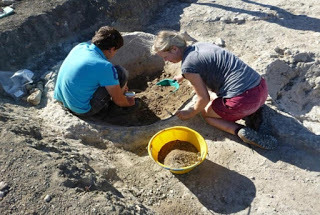 Archaeologists have uncovered a unique insight into the life of one of the Roman Empire’s most prominent landowners. Until now, very little has been known about these leaders, aside from their battle triumphs, territorial conquests, and monumental legacies.
Archaeologists have uncovered a unique insight into the life of one of the Roman Empire’s most prominent landowners. Until now, very little has been known about these leaders, aside from their battle triumphs, territorial conquests, and monumental legacies.
[image error][image error] Researchers investigating the vast Imperial estate of Vagnari in Italy, have unearthed evidence of wine production on a huge industrial scale. The discovery sheds light on their home life away from the battlefield.
The excavation team discovered the corner of a cella vinaria, a wine fermentation and storage room, in which wine vessels, known as dolia defossa, were fixed into the ground.
The heavy and cumbersome wine vessels have the capacity of more than 1,000 liters and were buried up to their necks in the ground to keep the temperature of the wine constant and cool—a necessary measure in hot climates.
Italian archaeologists set to produce ancient Roman wineArchaeologist attempts to revive lost alcoholic beverages from ancient recipes and residuesThe scale of the wine production offers clear evidence for industrial activities and provides a glimpse into the range of specialist crafts and industries practiced by residents—painting a better and more complete picture of life on the Imperial estate and the wealth it provided for its owner.
 Students excavating the Roman vicus at Vagnari, Italy. (
The University of Sheffield
)Vagnari is situated in a valley of the Basentello river, just east of the Apennine Mountains in Puglia (ancient Apulia) in southeast Italy.
Students excavating the Roman vicus at Vagnari, Italy. (
The University of Sheffield
)Vagnari is situated in a valley of the Basentello river, just east of the Apennine Mountains in Puglia (ancient Apulia) in southeast Italy.
After the Roman conquest of the region in the 3rd century BC, Vagnari was linked to Rome by one of Italy’s main Roman roads, the Via Appia.
Excavation and surveys since 2000 have offered evidence for a large territory that was acquired by the Roman emperor and transformed into Imperial landholdings at some point in the early 1st century CE.
Innocent boys meticulously excavated 1,400-year-old winepress in Israel The path of the Via Appia and of the Via Appia Traiana. (
Public Domain
)
The path of the Via Appia and of the Via Appia Traiana. (
Public Domain
)
 Archaeologists have uncovered a unique insight into the life of one of the Roman Empire’s most prominent landowners. Until now, very little has been known about these leaders, aside from their battle triumphs, territorial conquests, and monumental legacies.
Archaeologists have uncovered a unique insight into the life of one of the Roman Empire’s most prominent landowners. Until now, very little has been known about these leaders, aside from their battle triumphs, territorial conquests, and monumental legacies.[image error][image error] Researchers investigating the vast Imperial estate of Vagnari in Italy, have unearthed evidence of wine production on a huge industrial scale. The discovery sheds light on their home life away from the battlefield.
The excavation team discovered the corner of a cella vinaria, a wine fermentation and storage room, in which wine vessels, known as dolia defossa, were fixed into the ground.
The heavy and cumbersome wine vessels have the capacity of more than 1,000 liters and were buried up to their necks in the ground to keep the temperature of the wine constant and cool—a necessary measure in hot climates.
Italian archaeologists set to produce ancient Roman wineArchaeologist attempts to revive lost alcoholic beverages from ancient recipes and residuesThe scale of the wine production offers clear evidence for industrial activities and provides a glimpse into the range of specialist crafts and industries practiced by residents—painting a better and more complete picture of life on the Imperial estate and the wealth it provided for its owner.
“Before we began our work only a small part of the vicus, which is at the heart of the estate and its administrative core, had been explored though the general size and outline of the village had been indicated by geophysics and test-trenching,” says Maureen Carroll, professor of Roman archaeology at the University of Sheffield.
“The discovery that lead was being processed here at Vagnari is also particularly revealing about the environment in which the inhabitants of the village lived and potential health risks to which they were exposed. “Scrap lead found during excavation consisted of roughly torn and cut pieces taken from other objects such as pipes, vessels, and tools which had been collected to be re-worked. The substantial amounts of molten lumps of lead and smelting debris show that this activity was intensive. Finished lead products include weighs, fishing net weights, and sheet lead clipped into small squares—perhaps handy repair patches for mending tools and containers.”
 Students excavating the Roman vicus at Vagnari, Italy. (
The University of Sheffield
)Vagnari is situated in a valley of the Basentello river, just east of the Apennine Mountains in Puglia (ancient Apulia) in southeast Italy.
Students excavating the Roman vicus at Vagnari, Italy. (
The University of Sheffield
)Vagnari is situated in a valley of the Basentello river, just east of the Apennine Mountains in Puglia (ancient Apulia) in southeast Italy.After the Roman conquest of the region in the 3rd century BC, Vagnari was linked to Rome by one of Italy’s main Roman roads, the Via Appia.
Excavation and surveys since 2000 have offered evidence for a large territory that was acquired by the Roman emperor and transformed into Imperial landholdings at some point in the early 1st century CE.
Innocent boys meticulously excavated 1,400-year-old winepress in Israel
 The path of the Via Appia and of the Via Appia Traiana. (
Public Domain
)
The path of the Via Appia and of the Via Appia Traiana. (
Public Domain
)“Few Imperial estates in Italy have been investigated archeologically, so it is particularly gratifying that our investigations at Vagnari will make a significant contribution to the understanding of Roman elite involvement in the exploitation of the environment and control over free and slave labor from the early 1st century CE.Featured image: Roman archaeology Roman wine vat. Source: Yorkshirepost.com
“We now aim to determine how diverse the estate’s economy was, and how the cultivation of vines and wine-making fitted in to the emperor’s wider agricultural and industrial landscape. “Combining the archaeological and anthropological evidence has the potential to considerably advance our knowledge of health and disease in a rural population of Roman Imperial Italy.”
Published on April 17, 2016 03:00
History Trivia - Canterbury Tales told at court of Richard II
April 17

1397 Geoffrey Chaucer told the Canterbury Tales for the first time at the court of Richard II.

1397 Geoffrey Chaucer told the Canterbury Tales for the first time at the court of Richard II.
Published on April 17, 2016 01:30
April 16, 2016
Rare Collection of Shakespeare Plays Turns Up in Scottish Mansion
Live Science
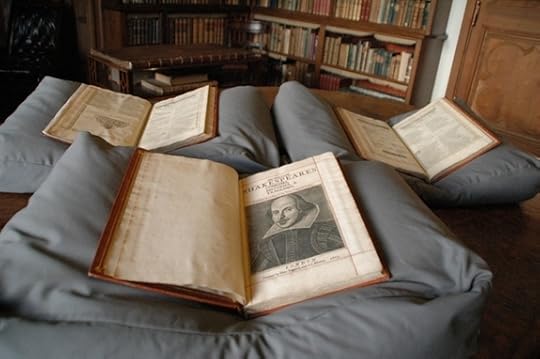
The First Folio was discovered in the collection of the Mount Stuart house , on Scotland's Isle of Bute.
, on Scotland's Isle of Bute.
Credit : Mount Stuart
: Mount Stuart
By Megan Gannon
William Shakespeare's First Folio —the Bard of Avon's first collected edition of 38 plays, published in 1623, shortly after his death —is among the world’s rarest and most valued books. Without it, we might not have ever known "Macbeth."
Now, a previously unknown copy has turned up in a Gothic mansion.
The folio was discovered in the collection of the Mount Stuart house, on Scotland's Isle of Bute, and ithas been authenticated by Emma Smith, a professor of Shakespeare at the University of Oxford. [History's 10 Most Overlooked Mysteries]
At the time of Shakespeare's death, at age 52 in 1616, only about half of his plays had been published. They typically appeared in quartos, which were small stand-alone editions that could be printed cheaply. Then in 1623, John Heminges and Henry Condell —who were part of the King's Men acting troupe —collected Shakespeare's comedies, histories and tragedies for a large-format folio edition.
Had the First Folio never been published, more than half of Shakespeare's plays might have been lost to history. "Julius Caesar," "Twelfth Night," "The Taming of the Shrew" and 15 other plays all appear in print for the first time in this collected edition.
The First Folio also includes as its frontispiece the Martin Droeshout portrait of Shakespeare, which is considered one of the rare reliable likenesses of the great playwright, as it was approved and published by his friends.
likenesses of the great playwright, as it was approved and published by his friends.
Scholars think that, at most, 750 copies of the First Folio were printed, according to the Folger Shakespeare Library in Washington, D.C. Of those, 234 are known to have survived, including the newly authenticated version. Slight differences in each copy are partly blamed on theproofingthat happened during printing. According to a statement from Mount Stuart, their version is unusual because it is bound in three volumes, with many pages left blank for illustrations, as well as for annotations and notes from its onetime owner Isaac Reed, who edited versions of Shakespeare's works in the 18th century.
"This is an exciting discovery because we didn't know it existed and it was owned by someone who edited Shakespeare in the 18th century," Smith said in the statement.
Reedapparently bought his copy of the First Folio in 1786 and records suggest it was sold after Reed's death in 1807 for a mere38 pounds ($54). Sometime after that, it ended up in Mount Stuart's collection.
The last time a new copy of the First Folio was authenticated was in 2014, when one of the books turned up at a public library near Calais in France.
When it comes to Shakespeare, authentication is crucial because forgeries and apocryphal works have been around for basically as long as Shakespeare. In the late 18th century, William Henry Ireland famously forged Shakespeare documents as well as a "lost play" called "Vortigern and Rowena," which was revealed to be a hoax soon after it was performed and ridiculed by the audience.
is crucial because forgeries and apocryphal works have been around for basically as long as Shakespeare. In the late 18th century, William Henry Ireland famously forged Shakespeare documents as well as a "lost play" called "Vortigern and Rowena," which was revealed to be a hoax soon after it was performed and ridiculed by the audience.
As for faking Shakespeare documents today, it seems the incentive is pretty clear: The auction record for a First Folio was set in 2001, when the New York auction house Christie's sold a copy for $6.16 million.
today, it seems the incentive is pretty clear: The auction record for a First Folio was set in 2001, when the New York auction house Christie's sold a copy for $6.16 million.

The First Folio was discovered in the collection of the Mount Stuart house
 , on Scotland's Isle of Bute.
, on Scotland's Isle of Bute.Credit
 : Mount Stuart
: Mount StuartBy Megan Gannon
William Shakespeare's First Folio —the Bard of Avon's first collected edition of 38 plays, published in 1623, shortly after his death —is among the world’s rarest and most valued books. Without it, we might not have ever known "Macbeth."
Now, a previously unknown copy has turned up in a Gothic mansion.
The folio was discovered in the collection of the Mount Stuart house, on Scotland's Isle of Bute, and ithas been authenticated by Emma Smith, a professor of Shakespeare at the University of Oxford. [History's 10 Most Overlooked Mysteries]
At the time of Shakespeare's death, at age 52 in 1616, only about half of his plays had been published. They typically appeared in quartos, which were small stand-alone editions that could be printed cheaply. Then in 1623, John Heminges and Henry Condell —who were part of the King's Men acting troupe —collected Shakespeare's comedies, histories and tragedies for a large-format folio edition.
Had the First Folio never been published, more than half of Shakespeare's plays might have been lost to history. "Julius Caesar," "Twelfth Night," "The Taming of the Shrew" and 15 other plays all appear in print for the first time in this collected edition.
The First Folio also includes as its frontispiece the Martin Droeshout portrait of Shakespeare, which is considered one of the rare reliable
 likenesses of the great playwright, as it was approved and published by his friends.
likenesses of the great playwright, as it was approved and published by his friends.Scholars think that, at most, 750 copies of the First Folio were printed, according to the Folger Shakespeare Library in Washington, D.C. Of those, 234 are known to have survived, including the newly authenticated version. Slight differences in each copy are partly blamed on theproofingthat happened during printing. According to a statement from Mount Stuart, their version is unusual because it is bound in three volumes, with many pages left blank for illustrations, as well as for annotations and notes from its onetime owner Isaac Reed, who edited versions of Shakespeare's works in the 18th century.
"This is an exciting discovery because we didn't know it existed and it was owned by someone who edited Shakespeare in the 18th century," Smith said in the statement.
Reedapparently bought his copy of the First Folio in 1786 and records suggest it was sold after Reed's death in 1807 for a mere38 pounds ($54). Sometime after that, it ended up in Mount Stuart's collection.
The last time a new copy of the First Folio was authenticated was in 2014, when one of the books turned up at a public library near Calais in France.
When it comes to Shakespeare, authentication
 is crucial because forgeries and apocryphal works have been around for basically as long as Shakespeare. In the late 18th century, William Henry Ireland famously forged Shakespeare documents as well as a "lost play" called "Vortigern and Rowena," which was revealed to be a hoax soon after it was performed and ridiculed by the audience.
is crucial because forgeries and apocryphal works have been around for basically as long as Shakespeare. In the late 18th century, William Henry Ireland famously forged Shakespeare documents as well as a "lost play" called "Vortigern and Rowena," which was revealed to be a hoax soon after it was performed and ridiculed by the audience.As for faking Shakespeare documents
 today, it seems the incentive is pretty clear: The auction record for a First Folio was set in 2001, when the New York auction house Christie's sold a copy for $6.16 million.
today, it seems the incentive is pretty clear: The auction record for a First Folio was set in 2001, when the New York auction house Christie's sold a copy for $6.16 million.
Published on April 16, 2016 02:30
History Trivia - Odysseus returns home
Published on April 16, 2016 00:30
April 15, 2016
Why are people of noble birth said to be ‘blue-blooded’?
History Extra

Detail from Très Riches Heures du Duc de Berry (The Very Rich Hours of the Duke of Berry), c1410
The concept likely originates in medieval Spain as ‘sangre azul’, and is attributed to the rich, powerful families of Castile. As part of their ‘pure Gothic’ descent, they would claim never to have intermarried with another race by drawing attention to their pale skin, which made the blueness of their veins visible.
An English publication of 1811 stated that the nobility of Valencia were divided into three classes – blue blood, red blood and yellow blood – with the first “confined to families who have been made grandees”. In the ninth-century, Spanish military noblemen reportedly proved their pedigree by displaying their visible veins to distinguish themselves from their darker-skinned Moorish enemy.
Throughout Europe it came to express the difference between the upper and lower classes – the former prizing their fashionable marble-like skin complete with visible veins, in contrast to the tanned skin of those toiling in the sun. Somewhat strangely to our eyes, a gentleman suitor might safely make a compliment to his lady’s turquoise veins, which were also often made prominent in early modern portraits of noblewomen. As a mark of nobility, it was truly desirable.
Answered by one of our Q&A experts, Emily Brand

Detail from Très Riches Heures du Duc de Berry (The Very Rich Hours of the Duke of Berry), c1410
The concept likely originates in medieval Spain as ‘sangre azul’, and is attributed to the rich, powerful families of Castile. As part of their ‘pure Gothic’ descent, they would claim never to have intermarried with another race by drawing attention to their pale skin, which made the blueness of their veins visible.
An English publication of 1811 stated that the nobility of Valencia were divided into three classes – blue blood, red blood and yellow blood – with the first “confined to families who have been made grandees”. In the ninth-century, Spanish military noblemen reportedly proved their pedigree by displaying their visible veins to distinguish themselves from their darker-skinned Moorish enemy.
Throughout Europe it came to express the difference between the upper and lower classes – the former prizing their fashionable marble-like skin complete with visible veins, in contrast to the tanned skin of those toiling in the sun. Somewhat strangely to our eyes, a gentleman suitor might safely make a compliment to his lady’s turquoise veins, which were also often made prominent in early modern portraits of noblewomen. As a mark of nobility, it was truly desirable.
Answered by one of our Q&A experts, Emily Brand
Published on April 15, 2016 03:00
History Trivia - Battle at Bedriacum
April 15

69 - Battle at Bedriacum, North-Italy fought during the Year of the Four Emperors, which resulted in Vespasian ascending the throne near the end of the bloody year of crisis

69 - Battle at Bedriacum, North-Italy fought during the Year of the Four Emperors, which resulted in Vespasian ascending the throne near the end of the bloody year of crisis
Published on April 15, 2016 02:00
April 14, 2016
Workers Building Parishioners a Toilet Unearth a Mass Anglo-Saxon Grave
Ancient Origins
 A group of more than 40 skeletons was found during the building of a new toilet for the parishioners of a church in Hildersham, Cambridgeshire, UK. The remains are about 900 years old.
A group of more than 40 skeletons was found during the building of a new toilet for the parishioners of a church in Hildersham, Cambridgeshire, UK. The remains are about 900 years old.
 [image error] According to the BBC, the burials are dated to the 11th or 12th century. Some of the graves lay 45 cm (18 in) below the path outside the Holy Trinity Church. They were dug into the chalk, with the bodies laid directly in the cavity. Most of the skeletons were of adults, but five of the individuals were children. The researchers examined 19 skeletons dated to the 9th or 10th century, predating the church by several hundred years, but they left 24 graves intact.
[image error] According to the BBC, the burials are dated to the 11th or 12th century. Some of the graves lay 45 cm (18 in) below the path outside the Holy Trinity Church. They were dug into the chalk, with the bodies laid directly in the cavity. Most of the skeletons were of adults, but five of the individuals were children. The researchers examined 19 skeletons dated to the 9th or 10th century, predating the church by several hundred years, but they left 24 graves intact.
According to Mr. Andrew Westwood-Bate, a local historian and the Holy Trinity churchwarden:
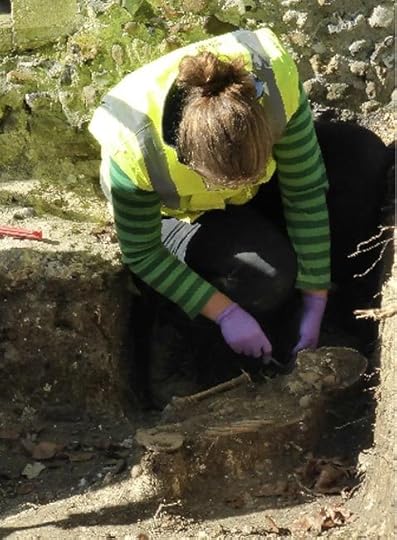
Excavating one of the skeletons. ( Andrew Westwood-Bate )The graves are said to be Anglo-Saxon, although Cambridge University Archaeological Unit experts who examined the site dated the bones to the 11th or 12th century. Until the discovery was made, there was no proof for the existence of a cemetery in this area. The researchers believe that the graves belonged to villagers who lived outside the walls of what was probably an Anglo-Saxon church.
Man Intent on Fixing Toilet Uncovers Centuries-Old Subterranean World Beneath his BasementArchaeologists piece together fragments from Anglo-Saxon gold hoard revealing stunning relicsDuring the excavations, the bones were stored in the mortuary at the village undertaker's for the night. After the end of the works, the skeletons were buried in one new grave. A funeral took place just before Christmas 2015, and the toilet was completed soon after. The new grave is commemorated by a sculpture made by Per Hall, a surgeon and sculptor from the village, who made a mold of the grave of one of the children. The church paid archaeologists £20,000 (approximately 28,500 USD) to examine the 19 intact skeletons and accomplish works.
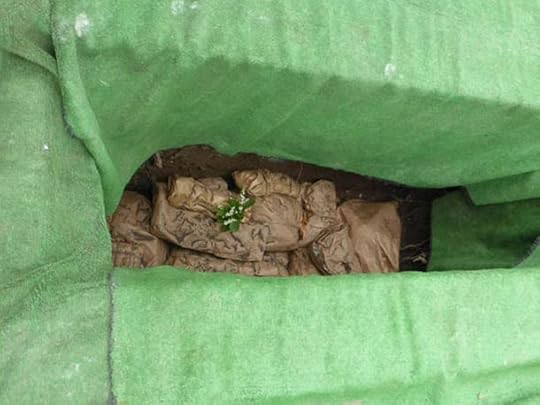 The skeletons were laid to rest together and a funeral was held before they were reburied. (
Andrew Westwood-Bate
)Another mass grave was found on September 2015, by workmen during the demolition of a Westminster Abbey toilet block. This burial contained about 50 individuals. The bones of men were thought to be connected with the events of 1066 in Westminster Abbey, when one king was buried and two were crowned in a year. The remains were discovered along with the skeleton of a child, no older than 3 years old, which was buried under the Victorian drainage pipes just outside the wall of Poet’s Corner.
The skeletons were laid to rest together and a funeral was held before they were reburied. (
Andrew Westwood-Bate
)Another mass grave was found on September 2015, by workmen during the demolition of a Westminster Abbey toilet block. This burial contained about 50 individuals. The bones of men were thought to be connected with the events of 1066 in Westminster Abbey, when one king was buried and two were crowned in a year. The remains were discovered along with the skeleton of a child, no older than 3 years old, which was buried under the Victorian drainage pipes just outside the wall of Poet’s Corner.
“What the child is doing there is one of the many unanswered questions, but it is a feature of many ecclesiastical sites that you find the remains of women and children in places where you might not quite expect them.” the Westminster Abbey’s archaeologist Warwick Rodwell told the Guardian.
 A painting of Westminster Abbey by Thomas H. Shepherd (1792-1864). (
Public Domain
)The skeleton of the child was small and not well preserved, so the determination of gender was impossible. The child was buried in a wooden coffin, unlike some of the monks buried nearby. It is unknown why the baby was buried there.
A painting of Westminster Abbey by Thomas H. Shepherd (1792-1864). (
Public Domain
)The skeleton of the child was small and not well preserved, so the determination of gender was impossible. The child was buried in a wooden coffin, unlike some of the monks buried nearby. It is unknown why the baby was buried there.
The remains of other individuals from the discovery are believed to be dated to the 11th or 12th century. The most interesting was a grave of a man buried in a grand coffin made of Barnack stone from Northamptonshire, whose skull was stolen by Victorian workmen. The remains were discovered previously by archaeologists in the 1950s, after a lavatory block was demolished to make the new tower.
Money Does Not Stink: The Urine Tax of Ancient RomeSaxon butter churn found in Staffordshire sheds light on life in Mercian KingdomThe history of finds related to toilets continues to be one of the most interesting parts of daily life. It contains the discovery of many surprising artifacts including jewelry, books, and organic remains. Another example from 2015 comes in the form of Polish archaeologists unearthing a 250-year-old sex toy during excavations in a latrine dated back to the 6th century AD.
While examining an ancient medieval port of Burgos in Bulgaria, archaeologists also discovered a number of artifacts which presented more on life in this area in the period from the 3rd to 6th century AD.
Featured Image: Skeleton of one of the individuals unearthed in Hildersham. Source: Andrew Westwood-Bate
By: Natalia Klimczak
 A group of more than 40 skeletons was found during the building of a new toilet for the parishioners of a church in Hildersham, Cambridgeshire, UK. The remains are about 900 years old.
A group of more than 40 skeletons was found during the building of a new toilet for the parishioners of a church in Hildersham, Cambridgeshire, UK. The remains are about 900 years old. [image error] According to the BBC, the burials are dated to the 11th or 12th century. Some of the graves lay 45 cm (18 in) below the path outside the Holy Trinity Church. They were dug into the chalk, with the bodies laid directly in the cavity. Most of the skeletons were of adults, but five of the individuals were children. The researchers examined 19 skeletons dated to the 9th or 10th century, predating the church by several hundred years, but they left 24 graves intact.
[image error] According to the BBC, the burials are dated to the 11th or 12th century. Some of the graves lay 45 cm (18 in) below the path outside the Holy Trinity Church. They were dug into the chalk, with the bodies laid directly in the cavity. Most of the skeletons were of adults, but five of the individuals were children. The researchers examined 19 skeletons dated to the 9th or 10th century, predating the church by several hundred years, but they left 24 graves intact.According to Mr. Andrew Westwood-Bate, a local historian and the Holy Trinity churchwarden:
"The discovery of the children was one of the most moving moments of the excavation. The graves were dug into the chalk and bodies laid directly in the cavity. When they were removed the bones were all put in bags and placed in a grave together. We gave them a proper funeral, again at 8am because we didn't want to draw any attention to ourselves. It was very moving and they have been laid to rest looking over the meadow where they would have lived when they were alive."

Excavating one of the skeletons. ( Andrew Westwood-Bate )The graves are said to be Anglo-Saxon, although Cambridge University Archaeological Unit experts who examined the site dated the bones to the 11th or 12th century. Until the discovery was made, there was no proof for the existence of a cemetery in this area. The researchers believe that the graves belonged to villagers who lived outside the walls of what was probably an Anglo-Saxon church.
Man Intent on Fixing Toilet Uncovers Centuries-Old Subterranean World Beneath his BasementArchaeologists piece together fragments from Anglo-Saxon gold hoard revealing stunning relicsDuring the excavations, the bones were stored in the mortuary at the village undertaker's for the night. After the end of the works, the skeletons were buried in one new grave. A funeral took place just before Christmas 2015, and the toilet was completed soon after. The new grave is commemorated by a sculpture made by Per Hall, a surgeon and sculptor from the village, who made a mold of the grave of one of the children. The church paid archaeologists £20,000 (approximately 28,500 USD) to examine the 19 intact skeletons and accomplish works.
 The skeletons were laid to rest together and a funeral was held before they were reburied. (
Andrew Westwood-Bate
)Another mass grave was found on September 2015, by workmen during the demolition of a Westminster Abbey toilet block. This burial contained about 50 individuals. The bones of men were thought to be connected with the events of 1066 in Westminster Abbey, when one king was buried and two were crowned in a year. The remains were discovered along with the skeleton of a child, no older than 3 years old, which was buried under the Victorian drainage pipes just outside the wall of Poet’s Corner.
The skeletons were laid to rest together and a funeral was held before they were reburied. (
Andrew Westwood-Bate
)Another mass grave was found on September 2015, by workmen during the demolition of a Westminster Abbey toilet block. This burial contained about 50 individuals. The bones of men were thought to be connected with the events of 1066 in Westminster Abbey, when one king was buried and two were crowned in a year. The remains were discovered along with the skeleton of a child, no older than 3 years old, which was buried under the Victorian drainage pipes just outside the wall of Poet’s Corner.“What the child is doing there is one of the many unanswered questions, but it is a feature of many ecclesiastical sites that you find the remains of women and children in places where you might not quite expect them.” the Westminster Abbey’s archaeologist Warwick Rodwell told the Guardian.
 A painting of Westminster Abbey by Thomas H. Shepherd (1792-1864). (
Public Domain
)The skeleton of the child was small and not well preserved, so the determination of gender was impossible. The child was buried in a wooden coffin, unlike some of the monks buried nearby. It is unknown why the baby was buried there.
A painting of Westminster Abbey by Thomas H. Shepherd (1792-1864). (
Public Domain
)The skeleton of the child was small and not well preserved, so the determination of gender was impossible. The child was buried in a wooden coffin, unlike some of the monks buried nearby. It is unknown why the baby was buried there.The remains of other individuals from the discovery are believed to be dated to the 11th or 12th century. The most interesting was a grave of a man buried in a grand coffin made of Barnack stone from Northamptonshire, whose skull was stolen by Victorian workmen. The remains were discovered previously by archaeologists in the 1950s, after a lavatory block was demolished to make the new tower.
Money Does Not Stink: The Urine Tax of Ancient RomeSaxon butter churn found in Staffordshire sheds light on life in Mercian KingdomThe history of finds related to toilets continues to be one of the most interesting parts of daily life. It contains the discovery of many surprising artifacts including jewelry, books, and organic remains. Another example from 2015 comes in the form of Polish archaeologists unearthing a 250-year-old sex toy during excavations in a latrine dated back to the 6th century AD.
While examining an ancient medieval port of Burgos in Bulgaria, archaeologists also discovered a number of artifacts which presented more on life in this area in the period from the 3rd to 6th century AD.
Featured Image: Skeleton of one of the individuals unearthed in Hildersham. Source: Andrew Westwood-Bate
By: Natalia Klimczak
Published on April 14, 2016 03:00
History Trivia - Battle of Forum Gallorum
April 14
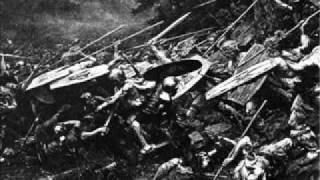
43 BC Battle of Forum Gallorum: Mark Antony, besieged Julius Caesar's assassin Decimus Junius Brutus Albinus in Mutina and defeated the forces of the consul Pansa, who was wounded

43 BC Battle of Forum Gallorum: Mark Antony, besieged Julius Caesar's assassin Decimus Junius Brutus Albinus in Mutina and defeated the forces of the consul Pansa, who was wounded
Published on April 14, 2016 01:30


